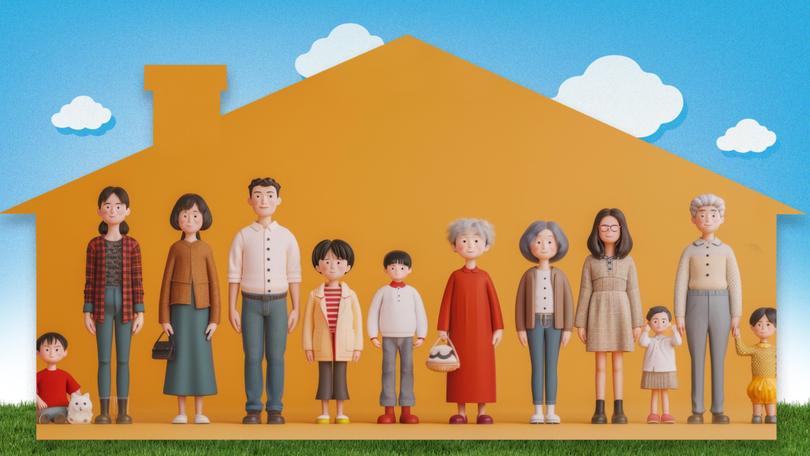GEMMA ACTON: Australia’s housing crisis means multi-generational living is back in style

After years of steadily worsening news, a glimmer of hope has appeared for renters with data from SQM Research showing the capital city asking rents came down by half a per cent during May.
Of course, there are caveats including that such prices often drop at this time of year. Moreover, it’s a national figure, so if you’re a tenant based in Brisbane, Adelaide or Perth, rents, unfortunately, went up again.
For those looking to jump onto the housing ladder, it’s tricky to find even a faint glimmer of hope, with dwelling values in Brisbane, Adelaide and Perth currently sitting at record highs. Sydney is likely to join them by month’s end while only Melbourne and Hobart are still below their peaks.
Sign up to The Nightly's newsletters.
Get the first look at the digital newspaper, curated daily stories and breaking headlines delivered to your inbox.
By continuing you agree to our Terms and Privacy Policy.More distressingly for those fighting hard to scrape together a deposit, in recent months, it’s the more affordable lower-quartile end of the market where prices have been accelerating the most.
Lest anyone think Australians lack perspective, confirmation that we’re entitled to our sense of gloom over housing arrived in the form of the latest Demographia global housing affordability report last week. This pinpointed Sydney as the world’s second-least affordable capital city (of the 94 analysed) with Melbourne and Adelaide joining it in the top 10 and Brisbane and Perth sitting safely within the top 20.
While transformative changes to the dire housing imbalance will take years to materialise thanks to the slow cycle of planning, acquiring permissions, financing, development and sales of new builds, we’re already seeing Australians take matters into their own hands.
Often you can’t break your rental contract and come up with a new lifestyle plan overnight but with rents now sprinting higher for more than two years, more tenants are moving further afield or into denser digs, teaming up to cohabit with friends or strangers.
I loved bunking in with friends for more than a decade but it really only works at certain times of your life. Much as my close friends profess to adore my toddler and newborn, I’m not sure any adore them enough to share a kitchen, bathroom and living area on a permanent basis.
Furthermore, I have no interest in cohabiting with any of their children or spouses. And yet it’s a quirk of our culture that at one of the times in life when you need the most support — juggling a young family — you’re least likely to be cohabiting with anyone except your spouse and offspring. The phrase “it takes a village” is spot on — and yet it’s been largely the exception, not the rule to live with family during those years which are overwhelming both practically and financially.
Of course, not all family dynamics support the possibility of multi-generational living but for the familial relationships that could withstand — or even be strengthened — by a spell under the same roof, it’s an option that’s increasingly being put on the table and adopted.
I spent three months living in my childhood home during maternity leave and while I had anticipated the practical and emotional support I gratefully received, I hadn’t expected how heart-warming I would find watching the bond grow between my parents and my girls.
If there’s a growing argument for the benefits of multi-generational living for young families, it’s long existed for older Australians who can draw on the vitality and security of being part of a younger household while making essential contributions of their own to the arrangement.
Increasingly, however, we’re hearing about the concept of multi-generational living for adolescents and their parents. These days, it’s unclear at exactly which age parents should expect their children to move out but it’s definitely becoming later and later.
In today’s world, frittering away hundreds of dollars a week on rent if you’re on an entry-level income and can stay a little longer at home is clearly the economically rational move. How else could you possibly hope to cobble together the tens of thousands required for a deposit for even a modest dwelling?
A Western Sydney-based interior architect last week told me that the only work he’s done all year is adding extensions onto family homes so parents can comfortably accommodate their adult children for years to come.
His core work used to be for house and land packages but given the soaring cost of land, labour and materials, some families that had been planning to help towards a mortgage deposit for their offspring, are now landing on a solution much closer to home.
A colleague also recently told me that they’d surprised themselves by moving into a new suburb they’d never previously considered having stumbled upon the “perfect” house. What made it perfect was a self-sufficient wing which they realised could comfortably house their three teenage children for however many years they opted to stick around.
While many communities represented in Australia have long valued multi-generational living, it’s a newer concept for others.
For those families who are heading down that path for the first time, there’s hopefully a lot more to be gained than just the (substantial) financial wins.
Gemma Acton is the Seven Network’s news operations director.

